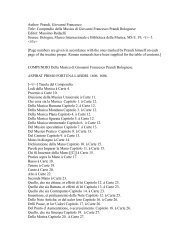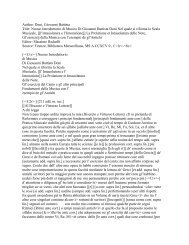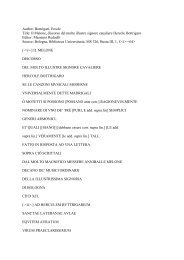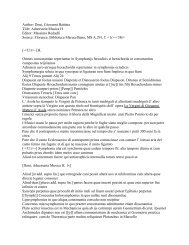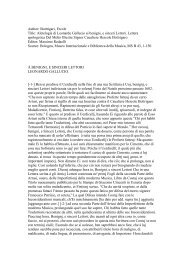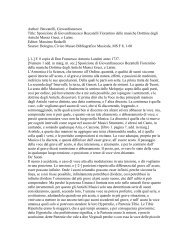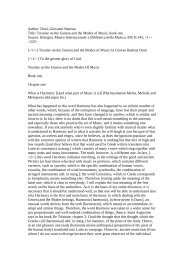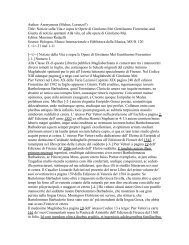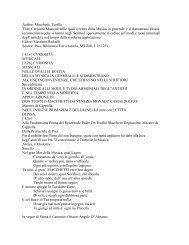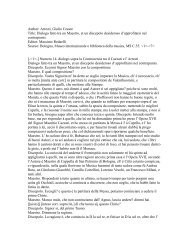Author: Dentice, Luigi - manuscripts of italian music theory in ...
Author: Dentice, Luigi - manuscripts of italian music theory in ...
Author: Dentice, Luigi - manuscripts of italian music theory in ...
Create successful ePaper yourself
Turn your PDF publications into a flip-book with our unique Google optimized e-Paper software.
notes, because there are fifteen notes from proslambanomenos to nete hyperboleon. The<br />
<strong>music</strong> writers <strong>of</strong> our time abandoned the geographical and numerical names and divide<br />
them <strong>in</strong>to eight parts, add<strong>in</strong>g to each trope its companion thus: the Under-Dorian to the<br />
Dorian, the Under-Phrygian to the Phrygian, the Under-Lydian to the Lydian and the<br />
Under-Mixolydian to the Mixolydian, so that the first consonances, namely the diapente<br />
and the diatessaron, were produced from these eight modes, and from the union <strong>of</strong> these<br />
two the diapason was sounded both ascend<strong>in</strong>g and descend<strong>in</strong>g. However, s<strong>in</strong>ce these<br />
tropes are located on four notes, namely, on hypate meson, parhypate meson, lichanos<br />
meson and mese, <strong>in</strong> each <strong>of</strong> them there are two. The Dorian is located <strong>in</strong> the first position,<br />
the Phrygian <strong>in</strong> the second one, the Lydian <strong>in</strong> the third one and the Mixolydian i the<br />
fourth one and they are called sublime, while the other four that accompany then are<br />
called conjo<strong>in</strong>ed. However, we call the sublime ones authentic and the conjo<strong>in</strong>ed plagal,<br />
and, <strong>in</strong>stead <strong>of</strong> call<strong>in</strong>g them Dorian, Phrygian, Lydian and Mixolydian tone, we call them<br />
first, third, fifth and seventh tone, while, correspondently, <strong>in</strong>stead <strong>of</strong> Under-Dorian,<br />
Under-Phrygian, Under-Lydian and Under-Mixolydian we call them second, fourth, sixth<br />
and eighth tone. However, before we evade completely the subject <strong>of</strong> the tropes, s<strong>in</strong>ce<br />
each <strong>of</strong> them consists <strong>of</strong> the species <strong>of</strong> consonances, it will not be <strong>in</strong>appropriate [-f.20r-]<br />
to say which are the species <strong>of</strong> whichever consonance; the species, I mean, to which said<br />
tropes belong, s<strong>in</strong>ce one has to expla<strong>in</strong> what one is go<strong>in</strong>g to do before what one has been<br />
done already. Therefore, s<strong>in</strong>ce the diatessaron conta<strong>in</strong>s four notes and three <strong>in</strong>tervals, as<br />
we have stated several times, and s<strong>in</strong>ce two tones and a semitone are located <strong>in</strong> the<br />
spaces, it is necessary, that the species will vary accord<strong>in</strong>g to the position <strong>of</strong> the semitone<br />
among the <strong>in</strong>tervals. Also, although the species <strong>of</strong> the diatessaron are conta<strong>in</strong>ed with<strong>in</strong> the<br />
same genus, nevertheless, s<strong>in</strong>ce there are three <strong>in</strong>tervals <strong>in</strong> that genus, it is necessary that<br />
it should have three species and no more than three, because the semitone, whose position<br />
determ<strong>in</strong>es the species, cannot be placed <strong>in</strong> a number <strong>of</strong> locations which is higher than the<br />
<strong>in</strong>tervals, as it can be found <strong>in</strong> the first one, <strong>in</strong> the middle one or <strong>in</strong> the last position. When<br />
it is <strong>in</strong> the middle one, we shall have the first species, when it is <strong>in</strong> the first position, we<br />
shall have the second one, and when it is <strong>in</strong> the last one, we shall have the third one.<br />
Therefore, the species will be three and no more than three, s<strong>in</strong>ce the semitone can be<br />
placed only <strong>in</strong> the positions that we have listed. However, s<strong>in</strong>ce these four notes are used<br />
<strong>in</strong> extended and prolonged sequences, and at times the voice rises and s<strong>in</strong>gs from the first<br />
to the last one without the <strong>in</strong>terven<strong>in</strong>g others, and at other times the other is sung next to<br />
them, as long as the sequence <strong>of</strong> the notes is observed and the semitone is located <strong>in</strong> its<br />
proper position, the species will rema<strong>in</strong> the same <strong>in</strong> that variety <strong>of</strong> notes, despite the fact<br />
that they are sung differently. The diapente has a note more than the diatessaron, hence<br />
the notes are five and the <strong>in</strong>tervals are four. It consists <strong>of</strong> three tones and a m<strong>in</strong>or<br />
semitone and four species are created accord<strong>in</strong>g to the different position <strong>of</strong> the semitone<br />
<strong>in</strong> its <strong>in</strong>tervals. Now, when the semitone is <strong>in</strong> the second position, the first species is<br />
created, when it is <strong>in</strong> the first, the second species, when it is <strong>in</strong> the third, the fourth species<br />
is formed. There are no more than four species <strong>in</strong> the diapente because the semitone can<br />
not be placed elsewhere but <strong>in</strong> these four <strong>in</strong>tervals. [-f.20v-] Also, although the melody<br />
unravels accord<strong>in</strong>g to the will <strong>of</strong> the composer without breaks, and sometimes the first<br />
note moves to the last one without touch<strong>in</strong>g the <strong>in</strong>terven<strong>in</strong>g ones and although sometimes<br />
the first one sounds together with the one next to it and with the last one, nevertheless,<br />
this variety does not prevent the fact that these sequences <strong>of</strong> sounds are classed under<br />
their own same species, as long as the appropriate movement <strong>of</strong> the notes is not marred<br />
and the m<strong>in</strong>or semitone is placed <strong>in</strong> its correct position. The consonance <strong>of</strong> the diapason<br />
conta<strong>in</strong>s and embraces the diatessaron and the diapente, hence it is necessary for them to<br />
encompass eight notes, seven <strong>in</strong>tervals and seven species. These species vary accord<strong>in</strong>g to



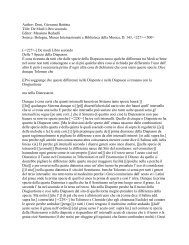
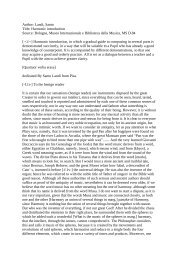
![Doni, Giovanni Battista Title: Trattato Dei Tuoni o [[Harmonie de]]](https://img.yumpu.com/45461005/1/190x245/doni-giovanni-battista-title-trattato-dei-tuoni-o-harmonie-de.jpg?quality=85)
